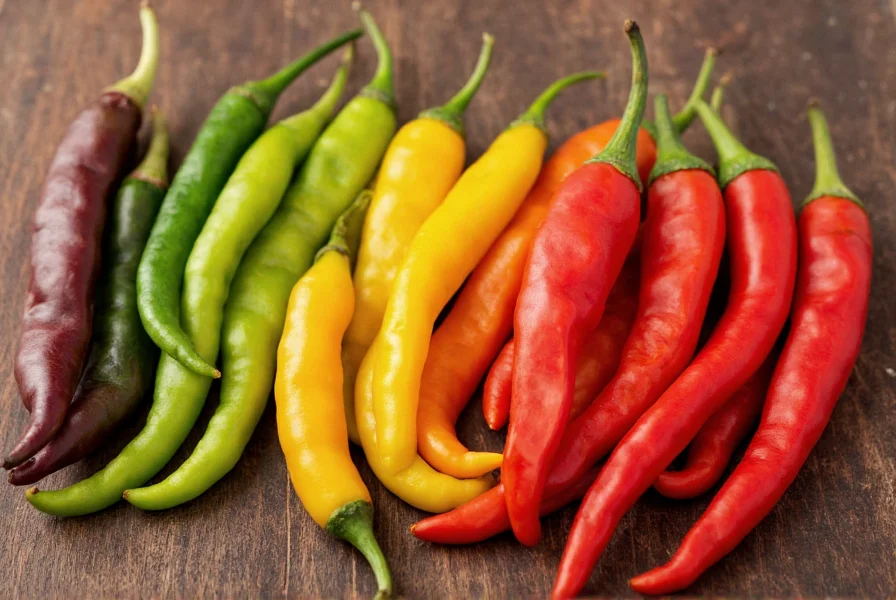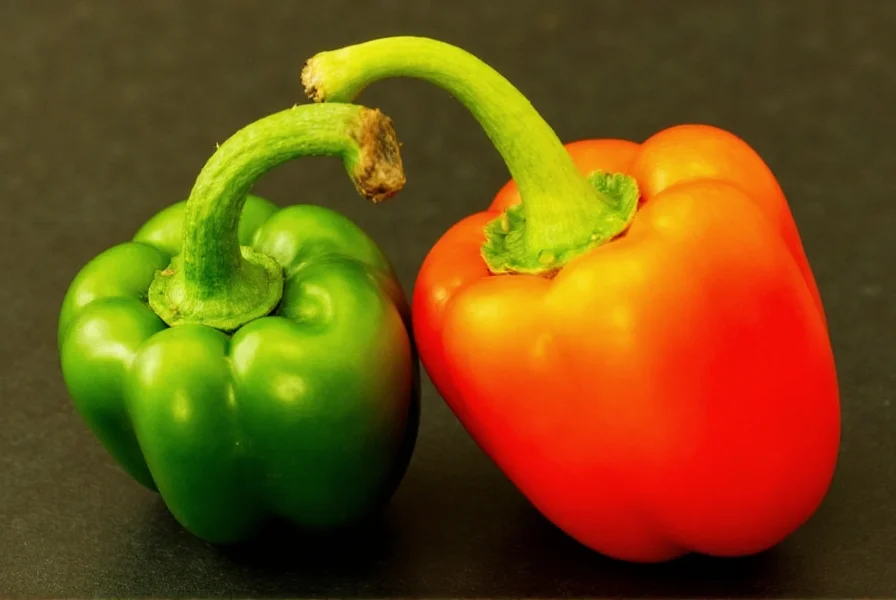There are over 50 commonly recognized chili pepper varieties worldwide, ranging from mild bell peppers (0 SHU) to extremely hot peppers like the Carolina Reaper (1,400,000-2,200,000 SHU). This comprehensive list categorizes chili peppers by heat level, flavor profile, and culinary uses, providing essential information for cooks, gardeners, and spice enthusiasts.
Chili peppers have captivated palates worldwide for centuries, offering diverse flavors and heat levels that transform ordinary dishes into extraordinary culinary experiences. Understanding the different types of chili peppers is essential for anyone looking to expand their cooking repertoire or gardening projects. This definitive guide presents a scientifically accurate list of chili peppers organized by Scoville Heat Units (SHU), with detailed information about each variety's characteristics, flavor profiles, and best culinary applications.
The Science Behind Pepper Heat: Understanding the Scoville Scale
The Scoville Scale, developed by pharmacist Wilbur Scoville in 1912, measures the pungency or 'heat' of chili peppers and other spicy foods. Originally determined through human taste testing, modern measurements use high-performance liquid chromatography (HPLC) for precise capsaicinoid concentration analysis. The scale ranges from 0 SHU for bell peppers to over 2 million SHU for the hottest commercially available peppers. When exploring our comprehensive list of chili peppers, understanding this measurement system helps predict how each variety will perform in your cooking.
Complete List of Chili Peppers by Heat Level
| Pepper Name | Scoville Heat Units | Flavor Profile | Common Culinary Uses |
|---|---|---|---|
| Bell Pepper | 0 SHU | Sweet, crisp, vegetal | Stuffed peppers, salads, stir-fries |
| Poblano | 1,000-2,000 SHU | Earthy, mild heat, slightly sweet | Chiles Rellenos, mole sauce, roasted dishes |
| Jalapeño | 2,500-8,000 SHU | Grassy, bright, medium heat | Salsas, nachos, pickled peppers, poppers |
| Serrano | 10,000-23,000 SHU | Sharp, bright, clean heat | Pico de gallo, hot sauces, guacamole |
| Habanero | 100,000-350,000 SHU | Fruity, floral, intense heat | Caribbean sauces, hot sauces, marinades |
| Ghost Pepper (Bhut Jolokia) | 800,000-1,041,404 SHU | Smoky, sweet, then extremely hot | Extreme hot sauces, competitive eating |
| Carolina Reaper | 1,400,000-2,200,000 SHU | Fruity, sweet, then devastating heat | Challenge sauces, specialty hot sauces |
Mild Chili Peppers (0-5,000 SHU)
Mild chili peppers serve as excellent entry points for those new to spicy foods while offering complex flavors that appeal to experienced palates. The poblano pepper, with its deep green color and heart-shaped form, provides earthy notes perfect for traditional Mexican dishes like chiles rellenos. When dried, it becomes the ancho pepper, essential for authentic mole sauces. The Anaheim pepper (500-2,500 SHU), often called 'long green,' offers a gentle heat ideal for Southwestern cuisine and stuffed pepper recipes. For gardeners seeking mild varieties, the Cubanelle (100-1,000 SHU) provides excellent frying pepper characteristics with its thin walls and sweet flavor.

Medium Heat Peppers (5,000-50,000 SHU)
Peppers in this category deliver noticeable heat while maintaining distinctive flavor profiles that enhance rather than overwhelm dishes. The jalapeño, perhaps the most recognized medium-heat pepper, varies significantly in spiciness depending on growing conditions and maturity. Red jalapeños (often labeled 'chipotles' when smoked) develop sweeter, more complex flavors as they ripen. The serrano pepper, smaller and typically hotter than jalapeños, offers a cleaner, brighter heat preferred in fresh salsas and guacamole. For those seeking something different, the fresno pepper (2,500-10,000 SHU) provides similar heat to jalapeños with a slightly fruitier profile, making it excellent for pickling and roasting. The cayenne pepper (30,000-50,000 SHU), commonly found dried and ground, delivers consistent heat perfect for adding spice to sauces, soups, and marinades without overwhelming other flavors.
Hot Peppers (50,000-300,000 SHU)
Hot peppers command respect in the kitchen, requiring careful handling but rewarding cooks with complex flavor profiles beyond simple heat. The habanero pepper, with its distinctive lantern shape and vibrant colors (typically orange or red), offers tropical fruit notes that balance its intense heat. Many Caribbean and Yucatecan dishes rely on habaneros for their signature flavor. The Scotch bonnet, closely related to the habanero, shares similar heat levels but features a more rounded shape and is essential in Jamaican jerk seasoning. For those exploring authentic Central American cuisine, the chiltepin (50,000-100,000 SHU), considered the original wild chili, provides intense, short-lived heat perfect for traditional salsas. The bird's eye chili (50,000-100,000 SHU), popular across Southeast Asia, delivers sharp, immediate heat ideal for Thai curries and Vietnamese dipping sauces.

Extremely Hot Peppers (300,000+ SHU)
Peppers in this category should be handled with extreme caution, often requiring gloves and careful ventilation. The ghost pepper (Bhut Jolokia), once holder of the Guinness World Record for hottest pepper, delivers intense heat that builds slowly then lingers. Its smoky-sweet initial flavor quickly gives way to significant burning sensation. The Trinidad Moruga Scorpion (800,000-2,000,000 SHU) features bumpy skin and unpredictable heat levels, making it popular among hot sauce enthusiasts. Currently holding the title of world's hottest pepper is the Carolina Reaper, developed by Ed Currie of PuckerButt Pepper Company. Its distinctive red, bumpy appearance hides a sweet-fruit flavor that precedes devastating heat. These super-hot peppers work best when used sparingly in sauces, infused oils, or for creating specialty hot sauces where a little goes a long way.
Practical Guide to Using Chili Peppers
Understanding how to work with different chili peppers enhances both safety and culinary results. When handling hot peppers, always wear gloves to prevent capsaicin transfer to sensitive areas. Remove seeds and white membranes (placenta) for reduced heat, as these contain most capsaicin. For consistent heat in recipes, consider using dried peppers or hot sauces with standardized Scoville ratings. Gardeners should note that environmental factors significantly affect pepper heat—stressors like drought or temperature extremes can increase capsaicin production. When substituting peppers, consider both heat level and flavor profile; a habanero won't work as a jalapeño replacement in most recipes due to its intense heat and different flavor characteristics. Proper storage extends pepper life—mild varieties last 1-2 weeks refrigerated, while hotter peppers can be frozen for up to 6 months without significant flavor degradation.
Conclusion
This comprehensive list of chili peppers provides essential information for navigating the diverse world of Capsicum varieties. Whether you're a home cook experimenting with new flavors, a gardener selecting varieties for your plot, or a culinary professional developing recipes, understanding the specific characteristics of each pepper type ensures better results. Remember that heat perception varies among individuals, so always taste-test peppers before incorporating them into dishes intended for others. The true art of working with chili peppers lies not just in managing heat, but in understanding how each variety's unique flavor profile can enhance your culinary creations.
What is the mildest chili pepper on the Scoville scale?
Bell peppers are the mildest variety with 0 Scoville Heat Units (SHU). They contain no capsaicin, the compound responsible for heat in chili peppers, making them completely non-spicy while offering sweet, crisp flavor profiles perfect for various culinary applications.
How can I reduce the heat of a chili pepper in cooking?
To reduce heat, remove the seeds and white membranes (placenta) where most capsaicin concentrates. Soaking sliced peppers in salt water or vinegar for 15-30 minutes can also draw out some heat. Cooking peppers longer breaks down capsaicin, while adding dairy products like yogurt or sour cream counteracts the burning sensation.
Which chili pepper is best for making hot sauce?
The best chili peppers for hot sauce depend on desired flavor profile. Habaneros provide excellent fruity notes with intense heat, making them popular in Caribbean-style sauces. For medium-heat sauces, serranos or jalapeños work well. Ghost peppers or Carolina Reapers create extremely hot sauces but should be used sparingly. Many professional hot sauce makers blend multiple pepper varieties to achieve balanced flavor and heat.
Do chili peppers lose heat when cooked?
Chili peppers don't necessarily lose heat when cooked, but the perception of heat can change. Capsaicin is stable up to 160°F (71°C), so brief cooking doesn't significantly reduce heat. However, prolonged cooking can break down capsaicin molecules slightly. More importantly, cooking distributes heat more evenly throughout a dish, which can make the heat feel less intense than when eating raw peppers. Frying or roasting can also caramelize natural sugars, creating flavor complexity that balances perceived heat.
What's the difference between red and green chili peppers of the same variety?
Red chili peppers are simply mature versions of green peppers of the same variety. As peppers ripen, they change color from green to red (or yellow, orange, purple depending on variety) and develop sweeter, more complex flavors while often increasing in heat. For example, a red jalapeño has approximately 20-30% more capsaicin than its green counterpart. The ripening process also increases vitamin content, with red peppers containing up to 9 times more beta-carotene than green versions.










 浙公网安备
33010002000092号
浙公网安备
33010002000092号 浙B2-20120091-4
浙B2-20120091-4